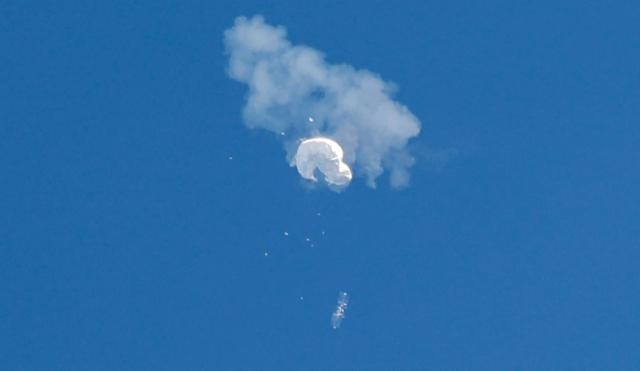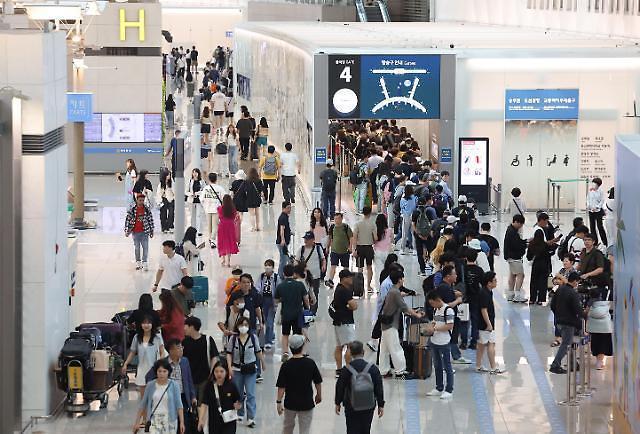
A suspected Chinese spy balloon drifts to the ocean after being shot down off the coast in Surfside Beach, South Carolina, the U.S., February 4. [Reuters/Randall Hill/Yonhap]

[Arthur I. Cyr]
By tangible contrast, there is no denying China has become aggressive in Asia, claiming territories and waters well beyond established jurisdictions. Conflicts are myriad and are occurring in the context of China’s massive, sustained military buildup.
At the start of February, the Philippines and the United States reached a major agreement to expand U.S. military presence to four additional military bases, beyond the five covered in the current Enhanced Cooperation Defense Agreement. This is a dramatic turnaround from the U.S. military departure from the Philippines three decades ago.
Beyond military defense, steady growth of Asia regional trade agreements provides practical though indirect deterrence of China military ambitions. In November 2020, East and Southeast Asian nations signed the Regional Comprehensive Economic Partnership (RCEP) agreement at a virtual summit hosted by Vietnam.
The list of members alone is impressive: Australia, Brunei, Cambodia, China, Indonesia, Japan, Laos, Malaysia, Myanmar, New Zealand, the Philippines, Singapore, South Korea, Thailand and Vietnam. These nations account for just under one-third of the total population of the globe, and nearly one-third of the total gross product of the world’s economies.
Two aspects of the agreement are particularly noteworthy. First, rules of origin are greatly simplified and standardized. These are the regulations that determine the country of origin of a product.
Previously, they varied widely among individual countries, imposing barriers to trade and hampering shipping and sales of products on a regional basis. In the future, there will be less obstruction of supply and distribution chains.
Second, this is the first comprehensive free trade agreement involving China, Japan and South Korea. All three nations historically have been at odds, and occasionally at war.
This comprehensive agreement builds on earlier much more limited accords of the Association of Southeast Asian Nations (ASEAN). The larger concept was developed at the ASEAN summit held in Bali, Indonesia, in 2011 and the first negotiations to realize the agreement were held in the 2012 ASEAN summit hosted in Cambodia.
The founding document of ASEAN was signed on August 8, 1967 by the foreign ministers of Indonesia, Malaysia, the Philippines, Singapore and Thailand. This was during the Vietnam War, and two years after the United States began comprehensive direct military involvement on the ground in South Vietnam, while significantly escalating air operations against North Vietnam as well as generally within the region.
An important later successful U.S.-led effort is Asia-Pacific Economic Cooperation (APEC), conceived by Australian Prime Minister Bob Hawke. President George H.W. Bush embraced the effort, and APEC began in 1989. The U.S. remains an active partner.
The 2006 APEC summit in Vietnam is noteworthy. Vietnam’s leaders honored U.S. Defense Secretary Donald Rumsfeld, a dramatic demonstration that economic self-interest, and the tangible benefits of trade and investment, can overcome even great political and ideological divides.
Looking to the future, RCEP could eventually restrain China’s sustained, sizable military buildup. The United States should work toward that goal.
Philippine-U.S. ties became close during World War II. The BBC notes the new defense accord “has stitched the gap in the arc of U.S. alliances” from Japan and South Korea in the north to Australia in the south.


![[OPINION] Assessing the trajectory of Chinas Economy: Growth or decline](https://image.ajunews.com/content/image/2024/01/31/20240131173956149557.jpg)
![[OPINION] CEWC 2024: Chinas strategic blueprint](https://image.ajunews.com/content/image/2023/12/21/20231221171623376236.jpg)
